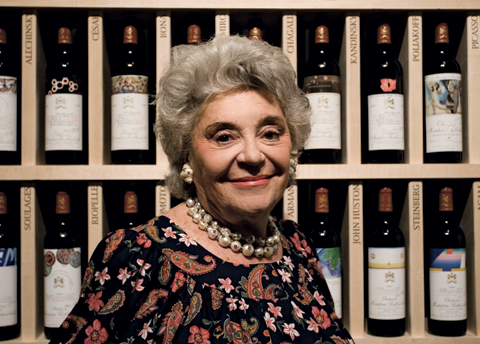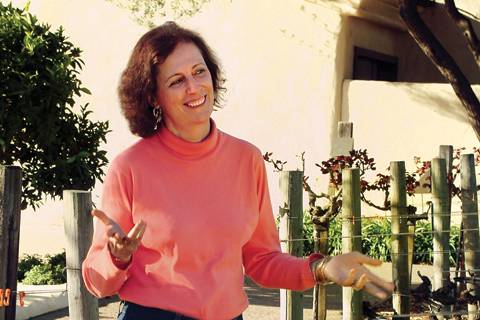Art and wine go hand in hand. Not only are both associated with sophistication, there is a level of appreciation that grows as knowledge about each subject is acquired. Sure, any lay person can see the aesthetic beauty of the Mona Lisa, but when one studies the 16th century portrait by Leonardo da Vinci and further comprehends not only the complexity of the brush strokes but the symbolism and history, admiration for the work is greatly enhanced.
The case is similar for a fine wine. Novices can enjoy the taste (or not), but the more that is learned about the grapes, vineyard, terroir, and aging process, the more a bottle can be appreciated for its purity and complexity.
Take, for example, a bottle from Château Mouton Rothschild. The vineyard, which is owned by Baroness Philippine de Rothschild and her children, is known the world over to produce one of the finest wines in existence. The vineyard is a premier cru class, which is a French term that denotes first growth. As it applies to wine from Bordeaux, premier crus classé is the highest level of red wine from the region. The history of the vineyard combines with the prestige of the family that owns it and creates a wine that excites the palate and pleases even the most discerning of wine critics. And while a novice certainly can swirl the wine from Château Mouton Rothschild in the glass and swish it through his or her mouth and appreciate the subtle notes and delicious complexity, one with a deeper comprehension of wine practices can detect the subtle nuances that make this wine one of the world’s best.
Château Mouton Rothschild comprises just less than 200 acres of vines at Pauillac in the Medoc region, planted with cabernet sauvignon, cabernet franc, merlot, and a small percentage of petit verdot. The vineyard, which was then called Château Brane-Mouton, was purchased by Baron Nathaniel de Rothschild in 1853 and promptly renamed Château Mouton Rothschild. Almost 70 years later, Baron Nathaniel’s great-grandson Baron Philippe began the process of elevating the estate to the level at which it is known today. In 1924, he was the first to introduce complete château bottling, which gave the vineyard a greater responsibility over its wine. In 1926, the Baron commissioned the now-famous Grand Chai, a majestic 100-meter barrel hall that remains one of the highlights of Mouton.
When the wars ended in 1945, Baron Philippe commemorated the occasion by commissioning a special label for that year’s vintage, with a design denoting V for victory. He became enamored with the idea of using the label to signify historical happenings, but quickly realized that it was more a love of art than of history. “While history and wine are a wonderful pair, art and wine go hand in hand,” explains Baroness Rothschild.
“There is no such thing as a favorite, because wines are always changing,”
Thus was the beginning of a tradition of unique artworks created specifcally to illustrate the labels of the vintages of Château Mouton Rothschild. In the years since, some of the world’s most important artists have submitted works for the Château. For 1958, it was Salvador Dalí; a bottle of the 1973 vintage wears a unique Pablo Picasso. The 1975 editions are adorned by an Andy Warhol that depicts Baron Philippe’s likeness, while for the 2004, HRH The Prince of Wales donated one of his watercolors for the bottle. These paintings, which range in size from miniscule to grand, were then shrunk down to bottle-size and recreated on the label.
This has resulted in an incredibly impressive collection of original artworks in the possession of the Château. That art collection grows by one incredibly important piece per year, and these artists receive no fee for their work. Instead, they are rewarded with cases of Mouton Rothschild. Baroness Rothschild is adamant that there is no formal selection process when it comes to the artists. “Just like every wine is different, every year is different,” she explains. “I select people I have known all my life. It’s a complete personal love affair with the artists. I would not put a painting that I do not like on the label.”
The most recently released vintage, the 2006, features a work by contemporary painter Lucien Freud. In 2008, one of his works sold for the highest price ever obtained by a living artist. The painting, which features a zebra and a palm tree, is an excellent addition to the Mouton portfolio, as is the wine. Baroness Rothschild does enjoy the vintage, despite favoring wines with a tad more age. “For me, a wine that is ready to drink has aged at least 10 years,” she explains.
However, she denies being able to chose a favored vintage of Mouton. “There is no such thing as a favorite, because wines are always changing,” she says. “If you taste a vintage one year and then try it again two years later, it is a completely different wine. That is what is so exciting and amusing, there is an extraordinary evolution in the wines of Mouton.”
That evolution is also visible in the labels. In 1981, Baroness Rothschild decided to showcase the unique collection of original artwork to the public with an exhibition dubbed Mouton Rothschild: Paintings for the Labels. This exhibition, which has traveled the globe since its inception, is currently on display in Miami Beach at the Wolfsonian museum, with a plan to head to Paris in the coming year.
The exhibit exemplifies Baroness Rothschild’s commitment to the arts, both classical and, of course, the art of winemaking. She has long had a love affair with the theater, and graduated from the Paris Conservatoire National d’Art Dramatique in 1958 and began performing with Comédie Français. In the subsequent years, she played one of the leading roles in “Harold and Maude,” but found herself organically drawn back to her family’s business. She took a more active role in the early 1980s with the launch of the exhibition of the artwork for the labels.
Baroness Rothschild also tends to the Museum of Wine and Art, which was founded in 1962 by Baron Philippe de Rothschild and his American wife, Baroness Pauline. “The museum has art objects of extraordinary quality dating from the Greeks and Egyptians to this time,” she explains.
Baroness Rothschild continually adds to the museum’s collection as she strives to continue her family’s legacy. Locally, that legacy includes a partnership with the Oakville vineyard Opus One, which began decades ago when her father Baron Philippe met Robert Mondavi during a trip to Hawaii. A joint partnership was proposed, but it was a decade before it was announced to the public. In 1984, the 1979 and 1980 vintages were simultaneously unveiled, and Opus One became America’s first ultra-premium wine. Her father unfortunately became unwell near the beginning of the venture, but Baroness Rothschild was there to step in. “I worked with Robert Mondavi directly while completing the winery, and now we have this place that I love,” she states. In 1988, upon the passing of Baron Philippe, Baroness Rothschild took over the family’s international wine business. The same year, Opus One became the first ultra-premium California wine to be sold in France, the U.K., Switzerland, and Germany. Today, Baroness Rothschild is still involved in the spirit of the Opus One winery, although she is not able to spend much time there, due to a hectic schedule.
Baroness Rothschild is constantly traversing the globe heading up her family’s winemaking efforts. In addition to Mouton Rothschild and Opus One, Mouton produces a premium white wine, Aile d’Argent, and a second red wine, Le Petit Mouton de Mouton Rothschild. In Chile, she oversees the creation of the premium red wine, Almaviva, and in Languedoc, the fine red wine Domaine de Baron’Arques. These are complemented by a number of branded vintages in France and Chile.
Do not ask her to compare her various wineries. “I never compare wines! I am against comparing wines, it’s a stupidity. Wine is what it is in itself. It’s funny because people always talk about comparing wines….I think a wine is what it is, whether it is good or bad.”
And her wines are excellent. Since the family’s motto is “I, Mouton, do not change,” one can expect all of Baroness Rothschild’s ventures to continue to display an unparalleled level of excellence that all wine drinkers can appreciate and that oenophiles can treasure for generations to come.





















